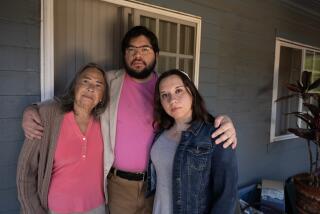Neighborhood Is All Revved Up Over Plan to Close Off Streets
- Share via
Santos Rodriguez, a retired aerospace engineer, spends at least a day a week on the golf course with a few of his neighbors from Lafayette Square.
They play in Whittier or Montebello, laughing, joking and discussing any issue that affects their lives and community--anything, that is, except for a plan to close off their streets, which has caused an undercurrent of tension even among chums.
At the request of a slim majority of homeowners in the exclusive neighborhood, the Los Angeles City Council unanimously approved plans to close the south, west and east entrances to the square by blocking the ends of the streets to create cul-de-sacs. If the plan wins final council approval on Tuesday, 237 homeowners would be assessed $40 per year for the next 10 years to pay for the enclosures.
Rodriguez, a leading opponent of the enclosure plan, disputes the claims of his golfing buddies that the cul-de-sacs will eliminate crime and traffic problems in the area west of Crenshaw Boulevard between Venice and Washington boulevards. Instead, he shares the concerns of transportation engineers who say that closing the streets will make getting in and out inconvenient for residents as well as for police, fire and other emergency vehicles.
One Way In and Out
The proposed cul-de-sacs will be Buckingham Road, Virginia Road, Wellington Road and Victoria Avenue at Washington Boulevard. Cul-de-sacs will also be created on St. Charles Place at Crenshaw Boulevard and at Buckingham Road. Drivers will be able to get into and out of the area only from Venice Boulevard.
“There are a lot of retired and elderly people in this neighborhood and one day their lives may depend on paramedics being able to get to their home in time,” said Rodriguez, who moved to Lafayette Square with his wife and eight children 36 years ago. “Besides, all the time we’ve lived here, we’ve never had any problems with crime.”
That is not the view of Rachel Lee, a leading supporter of the plan. She has lived in her big stucco home since 1954.
When Lee first moved there, she said she never worried about crime. But in recent years, she has become concerned about gang activity on her street, evidenced by newly painted graffiti, and drug busts at a couple of nearby homes.
“I want to preserve our neighborhood because it is being infiltrated by people who frighten me,” said Lee, a retired elementary school teacher. “People come driving through here late at night, playing their music really loud.”
But opponents of the plan insist that closing off the area is not going to eliminate crime.
“If crooks want to get to you, they will get to you,” said Loraine Mirza, who moved into the neighborhood in 1975 and heads the Lafayette Community Alliance. “They will either drive around to Venice Boulevard, or they’ll walk right up to your house.”
Another Motive
Alleviating traffic hazards was another motive for the cul-de-sacs, which were first called for almost 10 years ago by the Lafayette Square Assn.
Barbara Bourdeaux, president of the group, said, “People use our roads like speedways. They come zooming through. . . . I’ve seen cars totaled right in front of my house.”
But 87-year-old Agnes Boston says that Lafayette Square has never had traffic problems.
She moved into the exclusive enclave 55 years ago when it was crisscrossed by country roads and inhabited only by wealthy whites because deeds to the properties contained strict financial and racial covenants. There are blacks and Latinos living in the area now, while some whites have moved out.
“There is barely any traffic on these streets,” said Boston, a retired real estate broker. “You can sit in your car all day and count the number of cars that pass my house on one hand.”
Sees Traffic Increase
Mirza said the plan will actually increase traffic in the neighborhood because drivers, unaware of the enclosures, will try to use the streets to avoid the heavy traffic on Venice and Crenshaw boulevards, “but then they’ll have to turn right back around when they get to Washington (Boulevard) and drive back out.”
Robert Takasaki, a city transportation engineer who has reviewed the plans, agrees.
“Traffic within the square will probably be doubled, especially on the north-south streets,” he said. “Traffic on the streets right outside the square will also be increased.”
City Councilman Nate Holden, whose district includes Lafayette Square, has not met with anyone from the neighborhood to discuss blocking off the streets.
“This is a highly emotional issue. If you spend too much time with one side, the other side will get angry,” he said.
Holden said he will rely on recommendations of the Department of Transportation, which is expected to report on the plan Tuesday.
“I am going to let the facts speak for themselves,” said Holden, whose predecessor, David Cunningham, first brought the plan before the council. “. . . I am not going to ask the council to rescind their vote, unless I find out that the plans are unsafe.”
Safety is not the real reason the plan was proposed, Mirza contends.
“People just want to be able to say that they live in an exclusive neighborhood, and they think the enclosures will increase their property values,” she said. “I call it the snoot factor.”
Lee called that notion absurd. “We love our neighborhood and we just want to preserve it and get some good neighbors in here,” she said.
More to Read
Sign up for Essential California
The most important California stories and recommendations in your inbox every morning.
You may occasionally receive promotional content from the Los Angeles Times.













